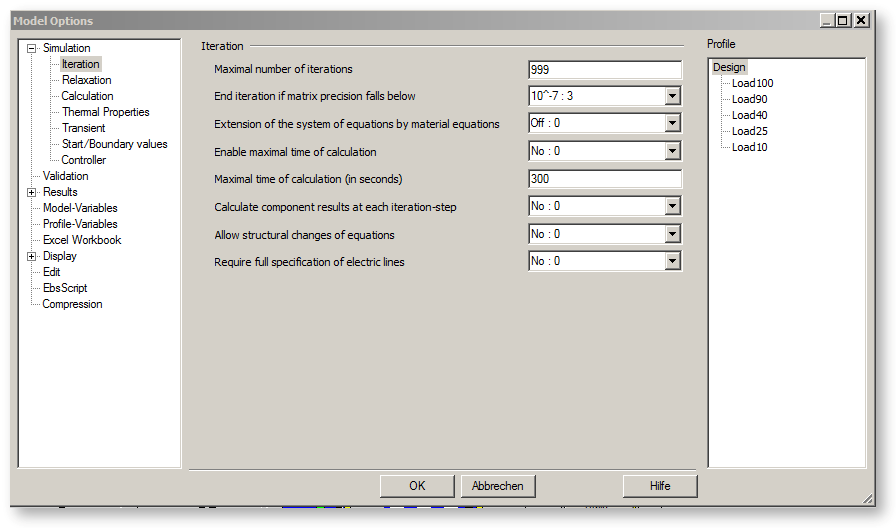


The ”Maximal number of iterations” limits the number of iterations to avoid an endless loop in case of bad convergence. The default value is 999 iterations.
In the combo-box “End iteration at a precision of” you can set the precision where the iteration should come to an end. For each pipe, the relative deviation between the actual value for mass flow, pressure and enthalpy and the corresponding value from the previous iteration step is calculated and the largest relative deviation is identified. The iteration stops, when this deviation is in the order of magnitude of the specified precision (for historical reasons, twice this value is used for mass flows and pressures, and three times this value is used for enthalpies).The default value is 10-7.
Only when the relative change in terms of its amount is smaller than this limit for all variables at all streams the iteration procedure will be successfully terminated.
Usually this relative change is related to the value of the variable. Thus if e.g. a mass flow changes from 50 to 51 kg/s, the relative change is 2 percent. At a convergence precision of 10-7 (this is the default value) this mass flow of 50 can only change by 0.000005 kg/s more (i.e. 5 mg/s) for this value to be considered convergent. At a mass flow of 0.01 kg/s the admissible change would then only be 10-9 kg/s. Such small changes, however, are not significant in practice and would unnecessarily prolong the iteration. In many cases no convergence could be achieved at all any more due to the “numerical noise“.
For that reason a minimum reference value for calculating the relative change had been defined in Ebsilon. When the value of the variable was smaller than the reference value, the relative change was not calculated with reference to the variable but with reference to the reference value. Thus (at a convergence precision of 10-7) mass flow fluctuations of less than 0.000002 kg/s, pressure fluctuations of less than 0.0000002 bar, and enthalpy fluctuations of less than 0.00006 kJ/kg were no longer considered an obstacle for the conversion.
It is possible to specify these minimum reference values individually for individual streams. This way, less interesting areas of the model can be calculated with a lower precision, which may reduce the computing time.
See "Individual Specification of the Convergence Precision " in Component 1 (Boundary ) and Component 33 (and Start Value).
"Level of integration of material equations" is used to define which variable shall be included in the matrix solution. By default, mass flows, pressures and enthalpies of all pipes are included in the matrix. Calorific values and compositions are transferred sequentially from component to component.
Optional it is possible to include calorific values and compositions in the matrix. This is necessary if calorific values and compositions shall be considered by the validation.
In simulation, there may be rare cases where this mode yields to an improvement of convergency (for models, where the distribution of composition is critical for the convergency). The disadvantage is that the number of equations increases by a factor of 10 and cause an increase in calculation time. It is not recommended to use this mode in simulation.
For pipes of type "universal fluid", this setting is not available.
It is possible to perform this integration just for the simulation (where the calculation time increase is approximately linear with the number of equations) or for simulation and validation (where the calculation time increases quadratically with the number of equations).
The "maximum time of calculation " should be used in online systems only, when it is important that the calculation ends within a specified time period, even if the results are useless. When this option is activated, the calculation stops somewhere. There may be arbitrary numbers in the components and pipes at this time which do not reflect physical reality.
Checkbox: Always calculate component results